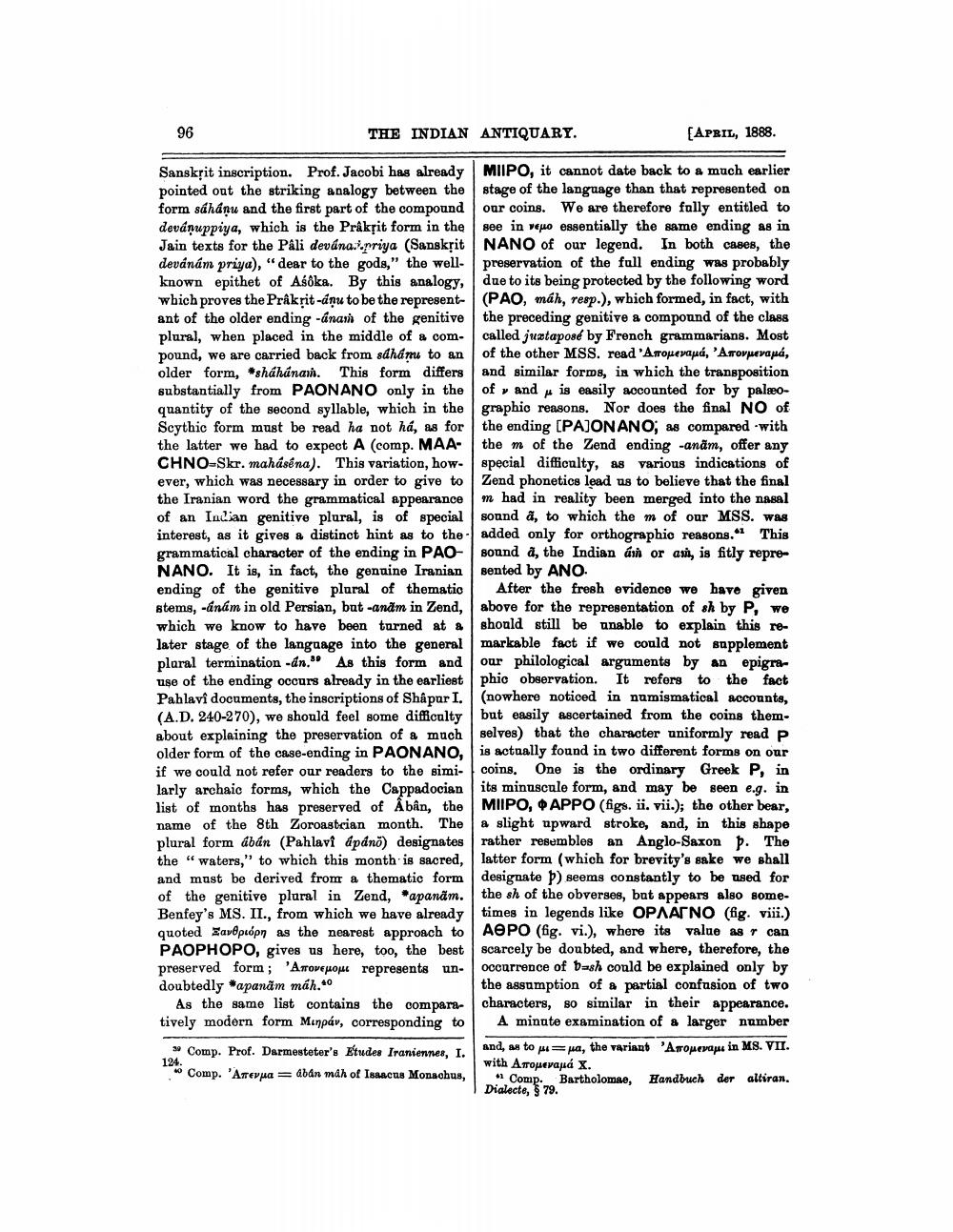________________
96
THE INDIAN ANTIQUARY.
[APRIL, 1888.
Sanskrit inscription. Prof. Jacobi has already MIIPO, it cannot date back to a much earlier pointed out the striking analogy between the stage of the language than that represented on form sáhánu and the first part of the compound our coins. We are therefore fully entitled to devánuppiya, which is the Pråkpit form in the see in quo essentially the same ending as in Jain texts for the Pali devána.priya (Sansksit NANO of our legend. In both cases, the devánám priya), “dear to the gods," the well- preservation of the full ending was probably known epithet of Asoka. By this analogy, due to its being protected by the following word which proves the Prakrit-anu to be the represent- (PAO, máh, resp.), which formed, in fact, with ant of the older ending -anas of the genitive the preceding genitive a compound of the class plural, when placed in the middle of a com- called juxtaposé by French grammarians. Most pound, we are carried back from sdháme to an of the other MSS. read 'Afropuerauá, 'Atroveraná, older form, *sháhánan. This form differs and similar forms, in which the transposition substantially from PAONANO only in the of and is easily accounted for by palæoquantity of the second syllable, which in the graphic reasons. Nor does the final NO of Scythic form must be read ha not há, as for the ending (PAJON ANO, as compared with the latter we had to expect A (comp. MAA- the m of the Zend ending -anăm, offer any CHNO-Skr. maháséna). This variation, how. special difficulty, as various indications of ever, which was necessary in order to give to Zend phonetics lead us to believe that the final the Iranian word the grammatical appearancem had in reality been merged into the nasal of an Indian genitive plural, is of special sound a, to which the m of our MSS. was interest, as it gives a distinct hint as to the added only for orthographic reasons. This grammatical character of the ending in PAO sound a, the Indian á or an, is fitly repreNANO. It is, in fact, the genuine Iranian sented by ANO ending of the genitive plural of thematic 1 After the fresh evidence we have given stems, -anam in old Persian, but-anam in Zend, above for the representation of sh by P, we which we know to have been turned at a should still be unable to explain this relater stage of the language into the general markable fact if we could not supplement plaral termination -an. As this form and our philological arguments by an epigrause of the ending occurs already in the earliest phic observation. It refers to the fact Pahlavi documents, the inscriptions of Shâpar I. (nowhere noticed in numismatical accounts, (A.D. 240-270), we should feel some difficulty but easily ascertained from the coins them. about explaining the preservation of a much selves) that the character uniformly read p older form of the case-ending in PAONANO, is actually found in two different forms on our if we could not refer our readers to the simi- coins. One is the ordinary Greek P, in larly archaic forms, which the Cappadocian its minuscule form, and may be seen e.g. in list of months has preserved of Åbân, the MIIPO, APPO (figs. ii. vii.); the other bear, name of the 8th Zoroastrian month. The a slight upward stroke, and, in this shape plural form ábán (Pahlavi ápáno) designates rather resembles an Anglo-Saxon p. The the "waters," to which this month is sacred, latter form (which for brevity's sake we shall and must be derived from a thematic form designate p) seems constantly to be used for of the genitive plural in Zend, *apanām. the sh of the obverses, but appears also someBenfey's MS. II., from which we have already times in legends like OPAANO (fig. viii.) quoted av@puópn as the nearest approach to AOPO (fig. vi.), where its value as can PAOPHOPO, gives us here, too, the best scarcely be doubted, and where, therefore, the preserved form; 'Atrovepome represents un occurrence of Dash could be explained only by doubtedly "apanām máh.
the assumption of a partial confusion of two As the same list contains the compara- characters, so similar in their appearance. tively modern form Minpáv, corresponding to A minute examination of a larger number Comp. Prof. Darmesteter's Etudes Iraniennes, I.
and, as to p=pa, the variant 'Arromerame in MS. VII. 124.
with Atropevajú X. Comp. 'Amevua = dban mdh of Isaacus Monachus,
"1 Comp. Bartholomae, Handbuch der altiran. Dialecte, $79.




